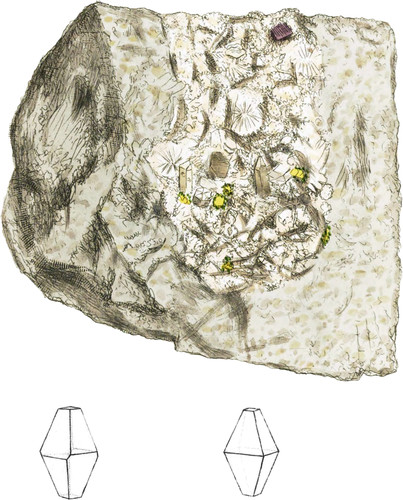 Enlarge
Enlarge
British Mineralogy
Hydrargillite
- Class 2. Earths.
- Order 1. Homogeneous.
- Gen. Argill.
- Spec. Hydrate of.
- Div. 1. Crystallized.
We feel much pleasure in presenting our friends with a figure and account of the most perfect and rare specimen yet found of this substance, and particularly so, as its crystals are very neat and perfect on all sides, although they will yet try the patience of a Crystallographer to make them out, since they are so small, clear, brilliant, and dazzling to the sight, like Diamonds, that their facets become multiplied. However, with a moderate light and good glasses they may be distinctly understood. At first sight they much resemble the octaëdral crystal of Sulphur, with the apex of the pyramids truncated*. The Rev. Mr. Gregor was so good as to inform me that this mineral was raised from the mine called Stenna-Gwyn in the parish of St. Stephen near Bran well in Cornwall, and that the crystals, besides Water and Alumine, as the principal ingredients, contain Lime and Silica in small proportions. One of these latter ingredients (or perhaps both of them) is probably united to Fluoric Acid. This acid, as well as the Lime and Silica, seem to exist in a somewhat larger proportion in this fossil than in the common Hydrargillite. Some of the crystals were put into a platinum crucible, and Sulphuric Acid dropped upon them. On exposing the vessel to a moderate sand-heat, the vapour of Fluoric Acid† was extricated; a piece of glass was put on the crucible, and a saline crust was deposited on it, which consisted of Fluoric Acid and Silica: as the surface of the glass was not corroded, it is inferred that the Silica was detached from the fossil. The Sulphuric Acid effected a solution of the whole, except a small portion of Silica, On the evaporation of the fluid, some Sulphate of Lime was separated, as well as as little Silica; on adding some Potash to the remaining fluid, crystals of Alum were from time to time produced, after repeated evaporations, to the last drop.
The angles of the mutual bases of the pyramids were found to be about 102° and 78°. The faces of the pyramids were near the base about 78° and 65°, making the summit 37°. The depth of the truncation, which is a primitive face, varied, The nucleus is a cube.
- * Although the largest crystals are not above half a line in length, yet my son was enabled to measure the angles by the help of a microscope; and as he performed this by a new method, I mention it for the sake of such as might find such a mode useful. It is by placing the crystal in the forceps, or by any other convenient way, under the microscope, using one eye to examine the angles, while with the other they are compared with other large ones formed on paper, and placed several inches below; so that when a second line is drawn on paper, only differing a degree or two, it may readily be ascertained which is the most correct. The error of course cannot be much, and this is a perfection which I believe has not been before stained, nor could it have been expected, in such minute crystals.
- † Mr. Davy has some time since determined that a small portion of Fluoric Acid, in a peculiar state, exists in the Devonshire Hydrargillite.

